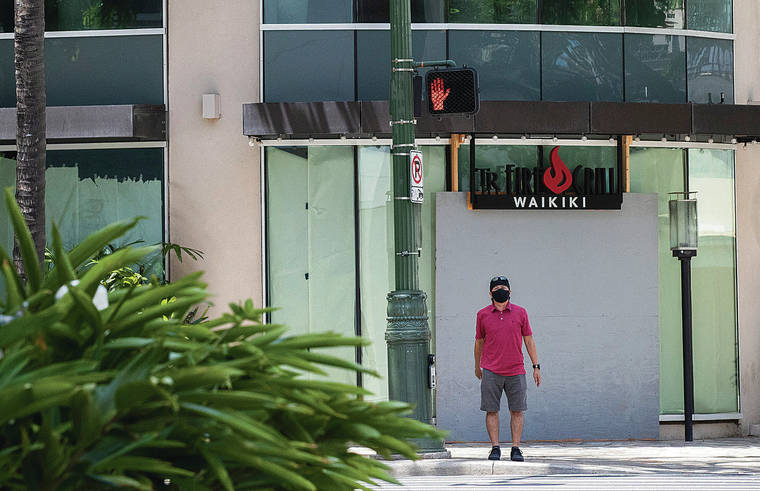Gov. David Ige’s decision to delay plans to reopen Hawaii tourism extends economic woes


CINDY ELLEN RUSSELL / CRUSSELL@STARADVERTISER.COM
The already struggling businesses dependent on tourism may have to wait even longer for visitors to come since Gov. David Ige announced Monday that he will wait until Sept. 1 to implement a new COVID-19 testing program for people traveling to Hawaii. Above, a pedestrian waited Monday at a crosswalk in front of the boarded facade of TR Fire Grill Waikiki restaurant.

CINDY ELLEN RUSSELL / CRUSSELL@STARADVERTISER.COM
Susan Anderson, pictured hugging her son Keala at Daniel K. Inouye International Airport, arrived from Utah on Monday. She and her family got tested in Utah “just to be sure we were safe,” she said. “I think that’s a sign of responsibility. We have family and so that’s why we’re willing to do this 14 days (quarantine).”

CINDY ELLEN RUSSELL / CRUSSELL@STARADVERTISER.COM
Erika Alexander picked up Brandon Walker on Monday at the airport. Walker, who flew in from Reno, Nev., said he supports the pre-travel COVID-19 testing program, adding that it would save him a lot more money than doing the 14-day quarantine.




Reaction was mixed Monday following Gov. David Ige’s decision to push back plans to use a pre-arrivals testing program to reopen Hawaii tourism.
Ige said Monday that the state will wait until Sept. 1 to begin a program to allow passengers with approved negative COVID-19 tests taken within 72 hours of their trip to Hawaii to bypass the state’s mandatory 14-day self-quarantine for out-of-state passengers.
Ige said an uptick in coronavirus cases in Hawaii and huge increases in some mainland states led government officials to reassess the plan. Ige said he’s also preparing to extend the mandatory 14-day self-quarantine for out-of-state passengers to the end of August.
“On the U.S. mainland we continue to see uncontrolled outbreaks and surges. This includes the highest number of daily cases in California, Texas, Arizona and Florida, and increasing cases in Nevada,” Ige said. “As we speak right now, the outbreaks on the mainland are not in control and we don’t believe that that situation would change significantly by August 1st as we had hoped.”
Hawaii experienced a record 42 cases on Saturday and only a few days before saw 41 cases, which was the record at the time. While the spike wasn’t unexpected and was within the capabilities of Hawaii’s health care system, it didn’t help that Honolulu-based Diagnostic Laboratory Services said Wednesday that its capacity for COVID-19 testing had decreased to 250 tests from 800 a day because of drastic cuts in access to reagents and other testing supplies.
Melvin Sakurai, a management consultant with Research Information Services, said “delaying the start is a very prudent and smart thing.”
Don't miss out on what's happening!
Stay in touch with breaking news, as it happens, conveniently in your email inbox. It's FREE!
Sakurai recommends that DOT take responsibility for effectively monitoring the airport’s primary portal of entry and that DOH must ensure adequate testing and contact tracing. He also supports mandatory re-testing of arriving visitors who intend to stay longer than two or three days.
“Given what we are seeing on the mainland, I feel no shame saying that it is a matter of life and death that Ige gets this reopening policy right. With a one- to two-week incubation period and thousands coming in, by the time we see evidence of a growing concern it will be too late and beyond control. What we see happened up to 2 weeks ago — and between now and then, countless more exposures happened and will boil up in the following weeks,” he said.
A Kauai COVID Group also has recommended a tougher testing program where a visitor would take a pre-arrival test and another test six days apart before being allowed out of a shorter quarantine.
Even at this late date, officials are still debating what requirements to include in a tourism reopening plan. However, few would quibble that the delay represents another devastating economic blow.
The state’s visitor industry, which supplies 17%, or the largest share, of the state’s GDP, began free-falling after Ige ordered a 14-day travel quarantine for out-of-state arrivals starting March 26. He also ordered an interisland quarantine on April 1, which ended June 16.
The quarantines weren’t very appealing to travelers, who were required to confine themselves in a designated location for two weeks after arriving in Hawaii or face up to one year in jail and a $5,000 fine.
Visitor arrivals fell nearly 99% in May amid COVID-19 fears and government lockdowns.
“If we have a testing program that allows them to come into the islands free and without the disease and we know that they’ve been tested. I think it’s no harm, no foul,” said longtime hotelier Jerry Gibson.”The pre-arrivals testing program just opens up the valve a little bit to the visitors who plan to follow the rules.”
Utah visitor Susan Anderson, who flew into Oahu on Monday as part of a group of nine people, said she was prepared to follow the quarantine, but supports the state’s pre-testing plan.
“We’re coming from Utah, where we actually did get tested, just to be sure we were safe. And I think that’s a sign of responsibility,” Anderson said. “We have family and so that’s why we’re willing to do this 14 days. Because we can’t travel — we’re both teachers — we can’t travel once fall starts, so this is the only time that we can even see (our son Keala). So it’s worth being quarantined.”
Still, not all visitors feel that way. On Sunday, only 505 of the 2,215 arriving passengers were visitors.
Barb Halpin of Longmont, Colo., said she and her family don’t want to travel to Hawaii during the quarantine and have rebooked their Aug. 1 trip to late September.
“It’s disappointing to have to cancel our trip, but we only half (at best) expected to be able to travel to Oahu on Aug. 1,” Halpin said. “I’m more concerned for the people of Hawaii whose jobs are tied to tourism, and I sincerely hope the state can settle on some sort of compromise that allows tourism to reopen but keeps Hawaii residents safe from experiencing a spike in cases.”
Halpin said she also hopes that Hawaii works out the kinks in its pre-arrivals testing program as she and other travelers feel that the 72-hour testing window is too restrictive and in some cases guidance is too lax.
Ige announced Monday that although the state does not plan to offer testing in Hawaii, it would allow travelers whose pre-arrivals testing results were delayed to get out of quarantine once they could produce an acceptable negative test result. He also clarified that testing would be required for travelers of all ages, including children.
“I think that’s a really good compromise,” Halpin said.
Businesses also want more cooperation from the state.
Sherry Menor-McNamara, Chamber of Commerce Hawaii president & CEO, is calling for state and county governments to deploy stabilization funds to help businesses survive the quarantine extension and establish a concrete screening and testing protocol.
“We have heard from many local businesses who made plans to reopen, bring back workers and invest in resources around the Governor’s Aug. 1 reopening date,” Menor-McNamara said. “We understand the need to put safety first, but the situation for many local businesses grows more dire by the day.”
Daniel Chun, spokesman for Alaska Airlines, said following Ige’s decision the carrier is re-evaluating its August schedule.
“We were planning a phased approach to reinstating our service to the islands next month, with some of our employees planning to return to work next week,” Chun said. ” This return-to-work plan will be affected by the delay of the pre-travel testing program until Sept. 1.”
Hawaiian Airlines, which is one of Hawaii’s largest employers, also now is scaling back plans to reinstate several North America routes next month, according to spokeswoman Tara Shimooka.
Through the CARES payroll support program, Hawaiian was able to avoid involuntary furloughs through September. However, Shimooka said the company continues ” to experience significant operating losses and do expect to have a smaller workforce as we enter (the fourth quarter) .”



